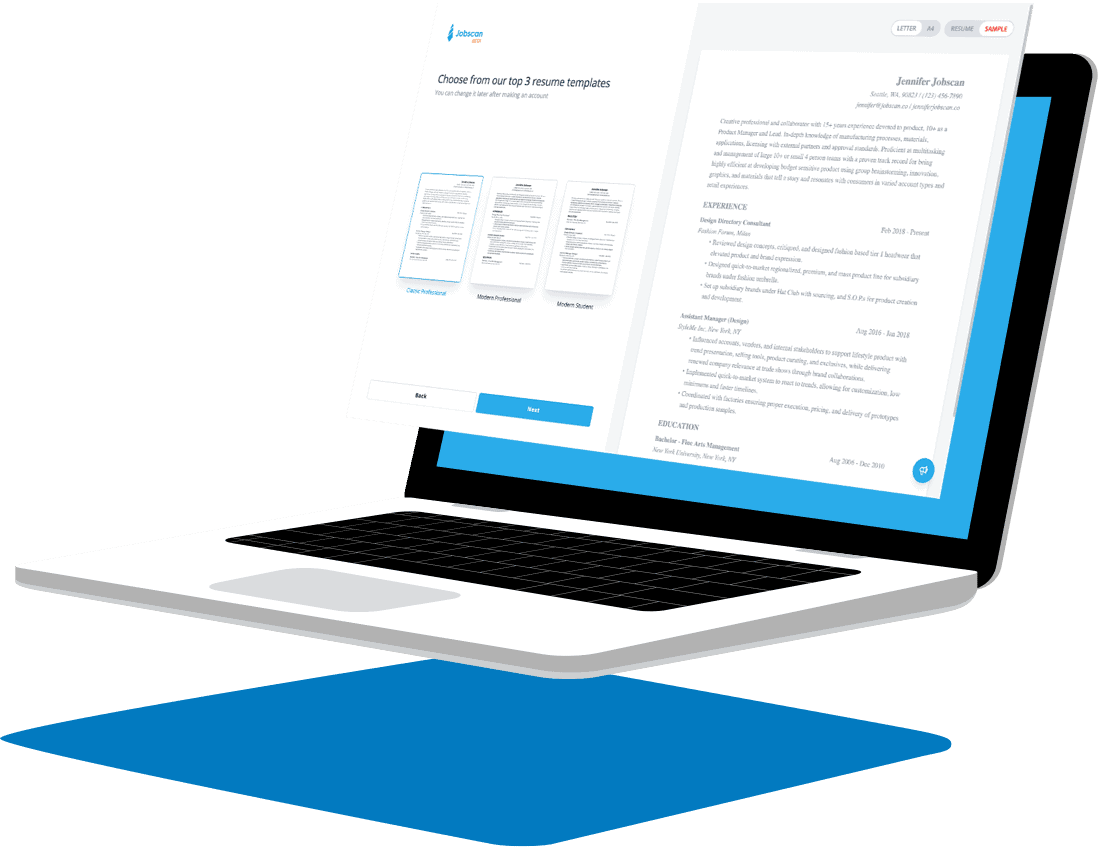Data Analyst Resume Examples, Skills, and Keywords
Writing a solid resume is an essential tool for breaking into the well-paying industry of data analysis. Here’s how to write a data analyst resume that gets you noticed by employers.
Optimize Your Resume Build a New Resume-
Jobscan has helped land interviews with
-
-
-
-
-
-
Data Analyst Resume Sample
As a data analyst, you may think that your most valuable skills revolve around data alone. While managing data is the core of data analysis, it’s not the only necessary skill set. Hiring managers check candidate resumes for a balance of specific hard skills (like understanding Python and Excel) and soft skills (like collaboration and public speaking).
A great data analyst resume will demonstrate both types of skills clearly. Potential employers want well-rounded candidates who can not just manipulate data but also present it clearly to others. Your resume is an excellent opportunity to demonstrate your communication skills upfront.
This data analyst resume example shows how you can neatly explain your experience and hard and soft skills on a single page.
Cleveland, OH 44101 • (555) 555-1234 • jordanmiller@email.com • linkedin.com/in/jordan-miller
DATA ANALYST
Analytical and solutions-driven professional with a computer science background and experience in the development, documentation, and delivery of process innovations. Process-oriented and skilled at transforming company practices into cost-effective solutions and more efficient operations.
Power BI Certification: Data Visualization | Microsoft Certifications: PowerPoint & Excel | Quantitative Methods | Data Warehousing | Advanced Data Mining | Business Intelligence (BI) | Google Analytics | Data Structures | Data Visualization | Data Mining & Analytics | Risk Management | Python Programming | Microsoft Office Suite | Python | R | SQL | C | C++ | Google Analytics | Power BI | SA | Microsoft Office Suite (Word, Excel, PowerPoint) | Windows
Led project management for Google Analytics projects, analyzing various company websites to extract customer insights regarding potential store locations, products trends, value-add trends, and more.
- Established analytics goals and used some advance Google Analytics features to extract customer information and also reviewed social media to determine, identify, and translate customer behavior; performed in-depth research and analysis on all available information
- Prepared and created analytic reports on customer insights such as user geographic location, age groups, and gender using Microsoft Excel (advanced), Word, and PowerPoint
- Presented findings to senior leadership to help inform critical decisions about products and increase brand recognition and customer base
- Made suggestions on which products to use as add-ons with others, based on customer data regarding which products customers would often buy together
Performed system analysis and application design, optimization, documentation, and development. Provided administration and technical support, analyzed reports, and identified opportunities for improvement.
- Led development of a 3-D game application using Unity software; rapidly acquired a deep understanding of the ongoing software in order to lead the team in game development
- Presented on the behalf of team, demonstrating the project objectives and the game itself
Learned a how to develop an Android based application.
- Developed a location-based application to track the user location using google API and display nearby essential locations such as hotels, police stations, and hospitals. Presented this application as a group project as a part of internship.
Smart IT – Android Application Development
Power BI Certification – Data Visualization
Microsoft Certifications – PowerPoint and Excel
Programming for Everyone
Python Data Structures
Using Python to Access Data
Resume written by Lezlie Garr
Data Analyst Resume Skills and Keywords
Data analysts need to have an in-depth understanding of many different programming languages and applications. Including these as resume skills is vital to getting your resume in front of hiring managers. These professionals are busy and use applicant tracking systems (ATS) to help filter out candidates who don’t use the resume keywords they’re looking for. Including specific data analyst skills helps your application get past the filters and get seen.
Top Data Analyst Resume Skills
- HTML
- Microsoft Excel
- Javascript
- Python
- Statistical programming languages
- A/B testing
- Data visualization
- Omniture
- Web analytics
- Collaboration
- Project management
- Critical thinking
- SQL
- Machine learning
- Data warehousing
- Research
- Attention to detail
- Problem-solving
- Data prep
- Statistics
- Verbal and written communication skills
- Presentation and public speaking
- Time management
- Domain knowledge
- System administration
- Organization
- Risk assessment
- Database design
- Tableau
- SharePoint
- Regression analysis
5 Resume Writing Tips for Data Analysts
Writing your resume involves more than simply listing your skills. Here are five tips that will help you create a resume that checks all the boxes at your preferred companies.
1. Introduce yourself well
First impressions are important. The first thing you say about yourself in your resume is your personal statement, also known as your resume summary. This is the first paragraph after the heading, and it’s often the only part of the resume a hiring manager will read before skimming the rest. Make the most of it by condensing your experience and skills into a few short sentences.
A great data analyst resume example summary is, “Knowledgeable data analyst focused on providing detailed reports and analyses to help guide business decisions at Brown Co. 5+ years of experience include reducing costs of manufacturing facilities by 17%, doubling rate of report generation, and automating 80% of data prep.”
This summary explains exactly what the applicant has done in the past and gives quantitative data to back it up. In the world of data analytics, hard numbers and verifiable metrics are critical measures of success. Including them in your personal statement shows you have the right mindset for the role.
2. Highlight your successes and experience
After you’ve introduced yourself, it’s time to list your experience in the field. This is no time to be humble.
You can use active language to be as clear as possible. Avoid vague terms like:
- Participated in
- Responsible for
- Attended
These phrases don’t explain what you actually did. Instead, use active verbs like:
- Managed
- Implemented
- Designed
- Wrote
- Built
- Organized
Specific terms let you save space and explain your duties quickly and easily. More importantly, they help you showcase your communication skills by avoiding passive voice and muddy descriptions.
Finally, it’s a good idea to list your experience in reverse chronological order. This method puts your most recent and most relevant experience at the top of the section. Hiring managers can see it at a glance instead of scanning through and possibly missing it.
3. List your certifications appropriately
Many data analysts continue to learn about their field as they continue their careers. If you’ve gotten any certification or taken continuing education courses in data analytics, you should give these certificates their own section. Splitting them out from your education header makes them easier to find and more likely to get noticed.
Common data analysis certificates include:
- Certified Analytics Professional (CAP)
- Associate Certified Analytics Professional (aCAP)
- Harvard University Business Analytics Course
- MCSE: Data Management and Analytics
Like your work experience, list these certificates in reverse chronological order, so the most current and presumably most advanced are at the top.
4. Include a skills section your most relevant analytical skills
Data analytics professionals like to be efficient. Adding a skills heading to your resume saves your potential employers some time and effort. They can scan your resume quickly, spot the skills you consider most important, and check for the abilities they need from a possible employee.
Listing your skills also lets you target more data analyst resume keywords. You can list proficiencies that don’t fit into other headings and highlight your most in-demand abilities. Putting your skill with Java and Tableau high in your skills section is a great way to get both ATS filters and hiring managers to pay attention to your application.
5. Don’t forget to proofread and polish your resume
Before you submit your resume, always give it one final glance. Your resume doesn’t have to be a work of modern art, but it should be straightforward and easy to read. Take a moment and make sure that the design isn’t cluttered and information is easy to find. Bullet points and bold and italic fonts are your friends.
You can also take a moment to proofread. If you’ve customized your resume for a specific position, make sure that all the information is correct. Data analysts have to be detail-oriented, so errors in your resume are a red flag for employers.








